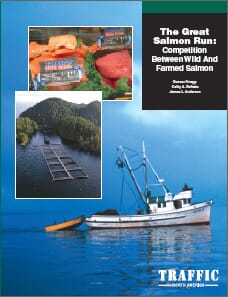 The Great Salmon Run: Competition BetweenWild And Farmed Salmon The Great Salmon Run: Competition BetweenWild And Farmed Salmon |
Key Points
- There is little doubt that most of the future growth in world salmon supplies will occur because of aquaculture, rather than increased harvests of wild salmon stocks. Salmon aquaculture will continue to develop in Northern Europe and to a lesser degree in North America (particularly Canada) but currently Chile has the greatest potential for growth.
- Aquaculture offers great advantages over capture fisheries, such as consistency of supply, yearround availability, greater quality control, and the possibility of longer-term contracts. In addition, the aquaculture sector is more attentive and has a greater capacity to respond to market demands. For example, large restaurant chains and supermarkets will increasingly source their supplies of fresh salmon from aquaculture. Wild salmon appears to be moving more toward the market extremes (Knapp 2001). On one hand, wild salmon are being sold into niche, high-end markets (e.g. Copper River salmon), and on the other hand, the bulk of the wild salmon is moving into certain low-end markets, such as frozen and canned fish (esp. pinks and chums). Because aquaculture contributes to low salmon prices, the economic incentive to enter into traditional salmon fisheries is reduced (Anderson 1985).
- Over the last two decades the global industry has been affected by cyclical movements of prices but consolidation processes and diversification into other species could bring some stabilization in the next years. Provided certain environmental concerns related to the integrity of wild stock populations and fishmeal content in salmon diets largely can be addressed, the future of the global salmon industry appears to be continued growth.
- However, the same cannot be said of the aquaculture industries in North America given the competition with overseas producers, heavy regulatory pressure, and confrontation with environmental groups. The U.S. ocean-pen salmon aquaculture industry may see some growth, but it will more likely contract in the near future. The Canadian ocean-pen aquaculture industry may see some growth in the future, but farmers will continue to struggle with stringent government regulations and opposition from environmental groups, particularly in British Columbia.
Further Information
To continue reading this article, please click herePrevious article from The Great Salmon Run,The World Salmon Farming Industry
To view further articles from The Great Salmon Run: Competition Between Wild And Farmed Salmon, please click here
April 2007


